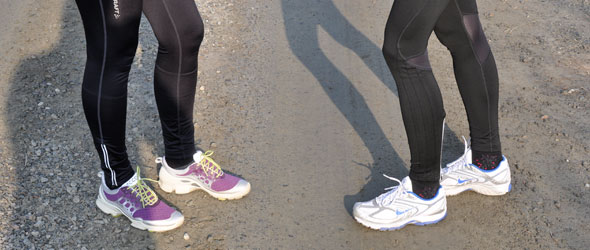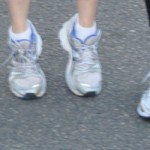45% of competitive female runners develop stress fractures, small cracks on the surface of the bones in their legs and feet. The women most likely to suffer these injuries are those who restrict food and those who have irregular periods.
Restricting food can stop a woman from menstruating regularly, which can stop her body from producing the female hormone, estrogen. Lack of estrogen weakens bones. Exercise does not cause irregular periods, not eating enough food does. Women who stop menstruating when they exercise heavily will usually start to menstruate regularly when they eat more food. Some women who suffer stress fractures will not heal until they take estrogen or other bone strengthening medications such as etidronate.
Stress fractures usually start out as a minor discomfort in the foot or leg,/ that occurs near the end of a long run. Usually the pain goes away as soon as the athlete stops running. On the next day, the pain returns earlier in the run. If she notices that it hurts to touch just one spot on a bone and then stops running for a week, she can return to running quickly, but usually she ignores the pain and develops a full- blown stress fracture and hurts all the time. She now has to avoid the hard pounding of running, but can ride a bike or swim for exercise until the fracture heals in 6 to 12 weeks. The most common sites for stress fractures are the bones in the front of the feet/ and the long bone of the lower leg, but running can cause stress fractures anywhere, even in the pelvic bones.
Stress fractures are exactly that: a bone cracks as a result of being subjected to forces that it cannot withstand. The resulting pain is such that it becomes impossible to continue to exercise. This makes it fairly easy to diagnose a stress fracture: there may be increasing discomfort over several days but most often the fracture happens suddenly, so the onset of pain is rapid and easily pinpointed.
Stress fractures are common among athletes. During a year long study 20% of track athletes developed fractures. Almost half of competitive female athletes develop fractures at least once in a lifetime, and they are more than twice as prone as males to fracture.
Exactly why and which bone fractures depends on a number of factors. Muscles act as shock absorbers (together with structures in the joints). Fatigued muscle is not able to absorb shock, so the impact stress is passed on to the bones (and joints). Bone is a dynamic structure, it can adapt if the load on it is increased, and in fact remodels itself according to the forces acting on it. However, a sudden increase in the load on bone due to a greater duration or intensity of work, or because of failure of the muscle to contain the impact forces, pushes the bone beyond its tensile limits and it breaks. A frequent fracture scenario is the athlete who is training hard, ignoring signals from sore and tired muscles while increasing mileage and running intensity, on unforgiving surfaces like the road or track.
Add worn shoes, some biomechanical imbalances and inadequate food intake and you have a stress fracture waiting to happen. Worn out shoes have lost their cushioning properties. Having legs of unequal length, even minutely so, creates all sort of misalignments and altered mechanical stress. Pronation refers to an inward rolling of the foot as strikes the ground and prepares for take off. During this process the entire lower limb and knee twist inwards, making significant demands on the bone to absorb these additional forces. Inadequate food intake contributes to overall fatigue but may also involve inadequate calcium and fat intake, which has implications for bone health.
Not surprisingly, over half of all the stress fractures occurring in runners develop in the lower leg (tibia (shin bone) and fibula) and foot (the metatarsal bones). Less common, but none the less painful are fractures to the pelvis and the hip, specifically the head of the femur where it inserts into the pelvis. Both of these are serious injuries, harder to diagnose and to live with than fractures in the lower limb.
Fractures are too subtle to be picked up on standard X-ray until they are at least 2-3 weeks old and the bone has started to form a ‘scar’ around the fracture site. A bone scan using dye to highlight areas of damaged or stressed bone does give one an idea of exactly where bone is undergoing major change or is overloaded but not that it is actually fractured. The best diagnosis remains subjective: pain in a very specific area, easily reproduced by pressing on the site and of such an intensity that the athlete cannot stand unsupported on the injured limb alone.
Typically, stress fractures take 6-8 weeks to heal, during which time weight-bearing exercise is impossible. Pelvic and hip fractures take much longer to resolve, about 12 weeks or more. The only helpful therapy for a stress fracture is complete rest of the limb where the fracture(s) are located, and correction of any biomechanical abnormality that contributed to the development of injury. For example, excessive pronation can be compensated for by the correct orthotics placed in the shoe. People with high arches are also prone to fractures, so inserts designed to support these arches are also useful.
Much has been made of the link between fracture risk and general bone health, this will be discussed in the following column.
Other Articles





























Speak Your Mind